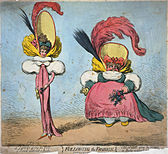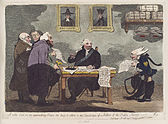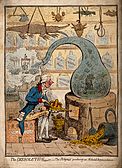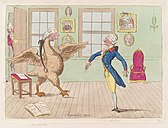James Gillray

James Gillray (13 August 1756[1] or 1757 – 1 June 1815) was an English caricaturist and printmaker famous for his etched political and social satires, mainly published between 1792 and 1810.
Gillray has been called "the father of the political cartoon", with his works satirizing George III, prime ministers and generals.[2] Regarded as being one of the two most influential cartoonists, the other being William Hogarth, Gillray's wit and humour, knowledge of life, fertility of resource, keen sense of the ludicrous, and beauty of execution, at once gave him the first place among caricaturists.[2][3]
Early life
He was born in Chelsea, London. His father, a native of Lanark, had served as a soldier, losing an arm at the Battle of Fontenoy, and was admitted, first as an inmate, and afterwards as an outdoor pensioner, at Chelsea Hospital. Gillray commenced life by learning letter-engraving, at which he soon became adept. This employment, however, proved irksome to James, so he wandered about for a time with a company of strolling players. After a very checkered experience he returned to London and was admitted as a student in the Royal Academy, supporting himself by engraving, and probably issuing a considerable number of caricatures under fictitious names. His caricatures are almost all in etching, some also with aquatint, and a few using stipple technique. None can correctly be described as engravings, although this term is often loosely used to describe them. Hogarth's works were the delight and study of his early years. Paddy on Horseback, which appeared in 1779, is the first caricature which is certainly his. Two caricatures on Admiral Rodney's naval victory at the Battle of the Saintes, issued in 1782, were among the first of the memorable series of his political sketches.
Adult life
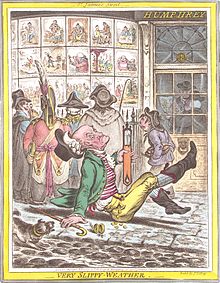

The name of Gillray's publisher and print seller, Miss Hannah Humphrey—whose shop was first at 227 Strand, then in New Bond Street, then in Old Bond Street, and finally in St James's Street—is inextricably associated with that of the caricaturist himself. Gillray lived with Miss (often called Mrs) Humphrey during the entire period of his fame. It is believed that he several times thought of marrying her, and that on one occasion the pair were on their way to the church, when Gillray said: "This is a foolish affair, methinks, Miss Humphrey. We live very comfortably together; we had better let well alone." There is no evidence, however, to support the stories which scandalmongers invented about their relations. One of Gillray's prints, "Twopenny Whist," is a depiction of four individuals playing cards, and the character shown second from the left, an ageing lady with eyeglasses and a bonnet, is widely believed to be an accurate depiction of Miss Humphrey.
Gillray's plates were exposed in Humphrey's shop window, where eager crowds examined them. One of his later prints, Very Slippy-Weather, shows Miss Humphrey's shop in St. James's Street in the background. In the shop window a number of Gillray's previously published prints, such as Tiddy-Doll the Great French Gingerbread Maker, Drawing Out a New Batch of Kings; His Man, Talley Mixing up the Dough, a satire on Napoleon's king-making proclivities, are shown in the shop window. His last work, from a design by Bunbury, is entitled Interior of a Barber's Shop in Assize Time, and is dated 1811. While he was engaged on it he became mad, although he had occasional intervals of sanity, which he employed on his last work. The approach of madness may have been hastened by his intemperate habits. Gillray died on 1 June 1815 in London, and was buried in St James's churchyard, Piccadilly.
The art of caricature

A number of his most trenchant satires are directed against George III, who, after examining some of Gillray's sketches, said "I don't understand these caricatures." Gillray revenged himself for this utterance by his caricature entitled, A Connoisseur Examining a Cooper, which he is doing by means of a candle on a "save-all"; so that the sketch satirises at once the king's pretensions to knowledge of art and his miserly habits.
During the French Revolution, Gillray took a conservative stance; and he issued caricature after caricature ridiculing the French and Napoleon (usually using Jacobin), and glorifying John Bull. A number of these were published in the Anti-Jacobin Review. He is not, however, to be thought of as a keen political adherent of either the Whig or the Tory party; his caricatures satirized members of all sides of the political spectrum.
The times in which Gillray lived were peculiarly favourable to the growth of a great school of caricature. Party warfare was carried on with great vigour and not a little bitterness; and personalities were freely indulged in on both sides. Gillray's incomparable wit and humour, knowledge of life, fertility of resource, keen sense of the ludicrous, and beauty of execution, at once gave him the first place among caricaturists. He is honourably distinguished in the history of caricature by the fact that his sketches are real works of art. The ideas embodied in some of them are sublime and poetically magnificent in their intensity of meaning, while the forthrightness—which some have called coarseness—which others display is characteristic of the general freedom of treatment common in all intellectual departments in the 18th century. The historical value of Gillray's work has been recognized by many discerning students of history. As has been well remarked: "Lord Stanhope has turned Gillray to account as a veracious reporter of speeches, as well as a suggestive illustrator of events."

His contemporary political influence is borne witness to in a letter from Lord Bateman, dated 3 November 1798. "The Opposition," he writes to Gillray, "are as low as we can wish them. You have been of infinite service in lowering them, and making them ridiculous." Gillray's extraordinary industry may be inferred from the fact that nearly 1000 caricatures have been attributed to him; while some consider him the author of as many as 1600 or 1700. According to the Encyclopædia Britannica Eleventh Edition, "Gillray is as invaluable to the student of English manners as to the political student, attacking the social follies of the time with scathing satire; and nothing escapes his notice, not even a trifling change of fashion in dress. The great tact Gillray displays in hitting on the ludicrous side of any subject is only equalled by the exquisite finish of his sketches—the finest of which reach an epic grandeur and Miltonic sublimity of conception."
Gillray's caricatures are generally divided into two classes, the political series and the social, though it is important not to attribute to the term "series" any concept of continuity or completeness. The political caricatures comprise an important and invaluable component of the history extant of the latter part of the reign of George III. They were circulated not only in Britain but also throughout Europe, and exerted a powerful influence both in Britain and abroad. In the political prints, George III, George's wife Queen Charlotte, the Prince of Wales (later Prince Regent, then King George IV), Fox, Pitt the Younger, Burke and Napoleon Bonaparte are the most prominent figures. In 1788 appeared two fine caricatures by Gillray. Blood on Thunder fording the Red Sea represents Lord Thurlow carrying Warren Hastings through a sea of gore: Hastings looks very comfortable, and is carrying two large bags of money. Market-Day pictures the ministerialists of the time as cattle for sale.


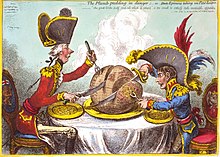
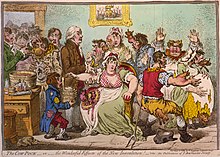


Among Gillray's best satires on George III are: Farmer George and his Wife, two companion plates, in one of which the king is toasting muffins for breakfast, and in the other the queen is frying sprats; The Anti-Saccharites, where the royal pair propose to dispense with sugar, to the great horror of the family; A Connoisseur Examining a Cooper; the paired plates A Voluptuary under the Horrors of Digestion and Temperance enjoying a Frugal Meal, satirising the excesses of the Prince Regent (later George IV of the United Kingdom) and the miserliness of his father, George III of the United Kingdom respectively; Royal Affability; A Lesson in Apple Dumplings; and The Pigs Possessed.
Other political caricatures include: Britannia between Scylla and Charybdis, a picture in which Pitt, so often Gillray's butt, figures in a favourable light; The Bridal Night; The Apotheosis of Hoche, which concentrates the excesses of the French Revolution in one view; The Nursery with Britannia reposing in Peace; The First Kiss these Ten Years (1803), another satire on the peace, which is said to have greatly amused Napoleon; The Hand-Writing upon the Wall; The Confederated Coalition, a swipe at the coalition which superseded the Addington ministry; Uncorking Old Sherry; The Plumb-Pudding in Danger (probably the best known political print ever published); Making Decent; Comforts of a Bed of Roses; View of the Hustings in Covent Garden; Phaethon Alarmed; and Pandora opening her Box.
As well as being blatant in his observations, Gillray could be incredibly subtle, and puncture vanity with a remarkably deft approach. The outstanding example of this is his print Fashionable Contrasts;—or—The Duchess's little Shoe yeilding [sic] to the Magnitude of the Duke's Foot. This was a devastating image aimed at the ridiculous sycophancy directed by the press towards Frederica Charlotte Ulrica, Duchess of York, and the supposed daintiness of her feet. The print showed only the feet and ankles of the Duke and Duchess of York, in an obviously copulatory position, with the Duke's feet enlarged and the Duchess's feet drawn very small. This print silenced forever the sycophancy of the press regarding the union of the Duke and Duchess.
The miscellaneous series of caricatures, although they have scarcely the historical importance of the political series, are more readily intelligible, and are even more amusing. Among the finest are: Shakespeare Sacrificed; Flemish Characters (two plates); Two-Penny Whist (which features an image of Hannah Humphrey); Oh that this too solid flesh would melt; Sandwich-Carrots; The Gout; Comfort to the Corns; Begone Dull Care; The Cow-Pock, which gives humorous expression to the popular dread of vaccination; Dilletanti Theatricals; and Harmony before Matrimony and Matrimonial Harmonics—two exceedingly good sketches in violent contrast to each other.
-
Flemish Characters (1793), published by G Humphrey, 27, St James's Street, Jan 1, 1822
-
Flemish Characters, published by G Humphrey, 27, St James's Street, Jan 1, 1822
Famous editions
A selection of Gillray's works appeared in James Gillray: The Caricatures printed between 1818 and the mid-1820s and published by John Miller, Bridge Street and W. Blackwood, Edinburgh. Nine parts were released. The next edition was Thomas McLean's, which was published with a key, in 1830.
In 1851 Henry George Bohn put out an edition, from the original plates in a handsome elephant folio, with coarser sketches—commonly known as the "Suppressed Plates"—being published in a separate volume. For this edition Thomas Wright and Robert Harding Evans wrote a commentary, a history of the times embraced by the caricatures. Many copies of the Bohn Edition have been broken up into individual sheets and passed off as originals (see Collecting below). Although the two volumes of the Bohn Edition are often represented as being a complete collection of Gillray's works, this is not the case: for example, Doublûres of Characters is not included in either volume. This is most likely because this print was not published by Hannah Humphrey, but by John Wright for the Anti-Jacobin Review and Magazine.
The next edition, entitled The Works of James Gillray, the Caricaturist: with the Story of his Life and Times (Chatto & Windus, 1874), was the work of Thomas Wright, and introduced Gillray to larger public. This edition, which is complete in one volume, contains two portraits of Gillray, and upwards of 400 illustrations.
Collecting
In recent years Gillray's work has become very collectible. Prices had been climbing steadily since the 1970s, but the auction of the Draper Hill Collection at Phillips auctioneers in London in 2001 pushed prices to new highs: several key prints, including Fashionable Contrasts, fetching more than US$10,000. Since 2002, annual auctions of Caricatures at Bonhams in London, each of which included large selections of Gillray prints, have continued this trend. Escalating prices have also meant that good examples of major works by Gillray can be very hard to come by at any price. Unfortunately for the beginning collector this means that starting a collection now is far more difficult than thirty years ago, when a very good copy of Light expelling Darkness could be had for as little as US$250. A good impression of this print sold in 2006 for over US$9,000, while Fashionable Contrasts also sold in the same year for over US$20,000.
This dramatic increase in prices has also led to unscrupulous sellers attempting to pass off prints from the Bohn Edition as originals, and it can be difficult for those unfamiliar with these practices to tell the difference between a restrike (commonly called "a Bohn") and an original. The key indicators of a print coming from the Bohn Edition are (i) the presence of a number in the top, right-hand corner of the print (the number is most commonly in the image itself, but may be outside in the margin); (ii) the fact that the Bohn edition was issued without colouring; and (iii) the fact that the strikes for the main published volumes of the Bohn Edition were printed on both sides of the paper (the Bohn Edition of the so-called "Suppressed Plates" was, like the originals, printed on one side of the paper only). However, the fact that a print is single-sided does not mean that it is not a Bohn restrike: there are in existence many Bohns (for example, Light expelling Darkness) that bear a number, but which are printed on one side of the paper only. These single-sided numbered strikes are almost always printed on much higher quality paper than was used for the bound volumes, and the quality of the printing is usually much superior too, with more care having been taken to ensure a crisp impression. These impressions are believed to have been struck by Henry Bohn with a view to colouring them, and then selling them as high-quality single prints, in much the same way as the prints published in Gillray's lifetime. There are many example of such single-sided restrikes, both coloured and uncoloured. Since prices for Bohns are usually between one-tenth and one-twentieth of those for originals, unscrupulous sellers will go to great lengths to disguise the fact that a print is a Bohn. Some common methods include: (i) tortuously worded descriptions, which attempt to avoid disclosure of the fact the print is a restrike (although some sellers will just plain lie); (ii) if the number is outside the image, trimming the print to the very edges of the image; (iii) if the number is inside the image, carefully abrading the surface to obliterate the number; (iv) cutting strips of the image to remove the number; (v) laying the print to paper or framing it such that it is difficult to determine whether there is printing on the reverse; and (vi) adding colour.
Also recently the prices of the John Miller editions are rapidly increasing in value because they are affordable for collectors and is seen as a solid investment. They are seen as good alternative to the desirable originals of Mrs. Humphrey's print shop.
Gallery
-
Light expelling Darkness,—Evaporation of Stygian Exhalations,—or—The Sun of the Constitution, rising superior to the Clouds of Opposition (1795)
-
Fashionable Contrasts;—or—The Duchess's little Shoe yeilding [sic] to the Magnitude of the Duke's Foot (1792)
-
"Short-bodied gowns", a Neo-Classical trend in women's clothing styles, the (1794)
-
The whore's last shift (1779)
-
A noble lord, on an approaching peace, too busy to attend to the expenditure of a million of the public money
-
A group of French savants huddle together at the top of a column
-
An alchemist using a crown-shaped bellows to blow the flames
-
Regardez moi (look at me)
Later life and death
Gillray's eyesight began to fail in 1806. He began wearing spectacles but they were unsatisfactory. Unable to work to his previous high standards, James Gillray became depressed and started drinking heavily. He produced his last print in September 1809. As a result of his heavy drinking Gillray suffered from gout throughout his later life.
In July 1811 Gillray attempted to kill himself by throwing himself out of an attic window above Humphrey's shop in St James's Street. Gillray lapsed into insanity and was looked after by Hannah Humphrey until his death on 1 June 1815.
James Gillray was buried in the courtyard of St James's Church, in Piccadilly, London.
Influence

Gillray is still revered as one of the most influential political caricaturists of all time, and among the leading cartoonists on the political stage in the United Kingdom today, both Steve Bell and Martin Rowson acknowledge him as probably the most influential of all their predecessors in that particular arena.
Regarded as being one of the two most influential cartoonists, the other being William Hogarth, Gillray has been called the father of the political cartoon.[2] The 20th-century New Zealander cartoonist David Low described Hogarth as the grandfather and Gillray the father of the political cartoon.[2]
In April 2012 the hotel chain Marriott International Inc. will open a steak restaurant in London's County Hall themed on Gillray's artwork called Gillray's Steakhouse & Bar.[7] The restaurant will feature key pieces of Gillray's artwork in the restaurant and in the menus.[8]
References
- ^ Gillray, James and Draper Hill (1966). Fashionable contrasts. Phaidon. p. 8.
- ^ a b c d "Satire, sewers and statesmen: why James Gillray was king of the cartoon". The Guardian. 16 June 2015.
- ^ "James Gillray: The Scourge of Napoleon". HistoryToday.
- ^ Wright T, Evans RH (1851). Historical and Descriptive Account of the Caricatures of James Gillray: Comprising a Political and Humorous History of the Latter Part of the Reign of George the Third. London: Henry G. Bohn. pp. ix. OCLC 59510372.
- ^ Martin Rowson, speaking on The Secret of Drawing, presented by Andrew Graham Dixon, BBCTV
- ^ Andrew Roberts, Napoleon: A Life (2014) p 316
- ^ "Gillray's Steakhouse & Bar". Marriott International Inc. Retrieved 14 March 2012.
- ^ "Gillray's Steakhouse & Bar to open at London's County Hall". Harpers Wine and Spirit Magazine, William Reed Business Media. Retrieved 14 March 2012.
External links
- James Gillray Gallery at MuseumSyndicate
- GreatCaricatures.com: James Gillray Galleries
- James Gillray at The National Portrait Gallery (United Kingdom).
- James Gillray and James Gillray: The Art of Caricature at The Tate Britain.
- James Gillray at The New York Public Library.
- James Gillray prints at the Lewis Walpole Library of Yale University.
- University of Nottingham Visual Resources - James Gillray cartoons
- Historical and Descriptive Account of the Caricatures of James Gillray by Thomas Wright, R. H. Evans
- Princeton University. Gillray Collection
- "James Gillray’s The Shrine at St Ann’s Hill and the Rights of Man". Academic Quarter, Fall 2012
- James Gillray: Caricaturist
- This article incorporates text from a publication now in the public domain: Chisholm, Hugh, ed. (1911). Encyclopædia Britannica (11th ed.). Cambridge University Press.
{{cite encyclopedia}}: Missing or empty|title=(help)




![Fashionable Contrasts;—or—The Duchess's little Shoe yeilding [sic] to the Magnitude of the Duke's Foot (1792)](http://upload.wikimedia.org/wikipedia/commons/thumb/e/e9/Fashionable_contrasts_james_gillray.jpg/168px-Fashionable_contrasts_james_gillray.jpg)
